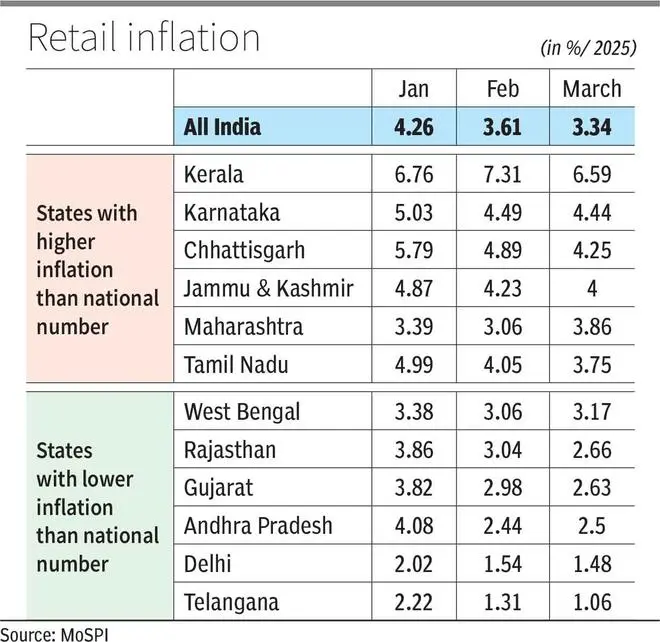Delhi maintained a lower rate throughout the fiscal year 2024-25
| Photo Credit:
SUSHIL KUMAR VERMA
Despite the overall decline, States including Kerala, Karnataka and Maharashtra registered retail inflation based on Consumer Price Index higher than the national headline. Weather factors, including rainfall and heatwaves, are further expected to impact State-wise figures as well as the headline number.
According to the Consumer Price Index Warehouse of the Statistics Ministry, at least six States with populations exceeding 50 lakh as per the 2011 census reported inflation numbers higher than the national average. These include Chhattisgarh, Jammu & Kashmir, Tamil Nadu, along with Kerala, Karnataka and Maharashtra. Except for one, all these States saw a drop in inflation, but still higher than the national headline. Although no state-specific reasons have been provided, there could be local issues affecting prices of various items, mainly food.
Five States and one Union Territory with populations exceeding 50 lakh saw inflation lower than the national number. These include West Bengal, Rajasthan, Gujarat, Andhra Pradesh, Delhi and Telangana. Delhi maintained a lower rate throughout the fiscal year 2024-25. At the same time, Telangana witnessed a very high rate in the first two months of the last fiscal, but subsequently, recorded lower inflation below the national number.

Weather Factor
Heat and monsoon are expected to influence food prices across various States and Union Territories. On Tuesday, the India Meteorological Department (IMD) forecast that while monsoon is likely to be above normal, there is concern about more days of heatwaves.
According to a research report by SBI, this is significant as the monsoon is crucial for India’s agriculture sector, which supports the livelihood of about 42.3 per cent of the population and contributes 18.2 per cent to the country’s GDP. Nearly 52 per cent of the net cultivated area depends on the primary rain-bearing system. It is also critical for replenishing of reservoirs, ensuring the availability of drinking water, apart from power generation,
A note by Barclays said: “We are mindful that seasonal factors for vegetable prices are set to worsen in summer. That said, we think price pressures will remain relatively benign.” It continues to expect inflation to average 4 per cent in FY26, the same as the RBI’s recently revised forecast. “The expectation of an ‘above normal’ monsoon by the Indian Meteorological Department augurs well for food inflation trajectory going forward,” the note said.
Dharmakirti Joshi, Chief Economist at Crisil Ltd, said the Indian Meteorological Department’s forecast of an above-normal monsoon for 2025 and Skymet’s forecast of a normal one add to the happy tidings on the food inflation front. On the other hand, a sharper-than-expected fall in crude oil prices will help keep non-food inflation comfortable as well. But “watch out for weather disruptions such as heat waves. For fiscal 2026, we expect headline inflation at 4.3 per cent with food, fuel and core readings at 4.6 per cent, 2.5 per cent, 4.2 per cent, respectively,” he said.
Published on April 15, 2025
Source link
[ad_3]
[ad_4]

